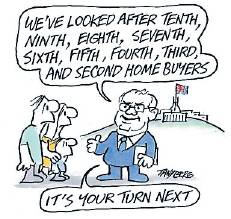Bond plan for cheap housing
Budget UK model eyed
EXCLUSIVE
James Massola
Chief Political Correspondent
Tens of millions of dollars could be pumped into low-cost community housing under a budget initiative being strongly considered by the federal government.
As governments at all levels grapple with Australia’s housing affordability crisis, work has been under way for months on new ways to fund community housing, using a so-called ‘‘bond aggregator’’ model based on an approach taken in Britain.
It’s hoped the scheme could kickstart construction of hundreds of new community houses at the lower end of the market, particularly in Sydney and Melbourne, and would assist people struggling to find an affordable home to rent.
Treasurer Scott Morrison will discuss the proposal with his state and territory counterparts in Canberra on Friday week.
Several government sources told Fairfax Media the institute’s proposal to create a new housing finance corporation was being looked at closely, and that the Treasurer was ‘‘very engaged in this, he is very directly involved in its construction’’.
Research on a bond aggregator model by the housing think-tank, the Australian Housing and Urban Research Institute, which Mr Morrison is scheduled to address in Melbourne on April 10, went to state and federal governments last December and the federal government will now create an implementation taskforce that will take charge of the plan.
Fairfax Media has been told by senior government sources the taskforce will closely examine the bond aggregator proposal, among others, to create an Affordable Housing Finance Corporation.
The institute’s proposal would see the corporation source large amounts of capital from the bond market – starting from $50 to $200 million – and then provide longerterm, lower-interest loans to the community housing sector.
Community housing providers, which provide affordable properties to rent, typically pay higher interest rates and have shorter terms in which to repay loans.
By assessing and then combining a series of loan applications from community housing groups, an AHFC could raise large sums of money at lower rates and for longer terms and then distribute the money, while lowering costs for community housing groups.
Crucially, the AHFC would enjoy the backing of the federal government’s balance sheet, but the proposal would not cost the federal government money – unless a provider defaulted on the loan.
Mr Morrison has signalled the May budget will have a range of policy measures designed to tackle housing affordability, both for renters and for first home buyers, and in January, ahead of a trip to study the British system, he hinted he was interested in implementing a similar government-backed bond vehicle.
Senior government ministers are still at loggerheads over whether to reduce capital gains tax concessions for housing, with Mr Morrison in favour and Finance Minister Mathias Cormann opposed to any change.
‘‘Rent to buy’’ and shared equity housing models, both of which are used in Britain, are also being examined. Another proposed to allow first-time buyers to use their superannuation as a home deposit has been discussed, although the government has apparently now cooled on this proposal.
In addition, the government has signalled that a separate pot of government money for affordable housing, the National Affordable Housing Agreement, could be scrapped with a savings of about $1.3 billion a year in payments to the states.
The last meeting of state and federal treasurers in December flagged the creation of the affordable housing taskforce. It is due to report back to the heads of state and federal treasuries by mid-2017.
